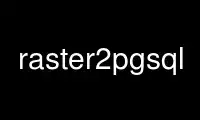
This is the command raster2pgsql that can be run in the OnWorks free hosting provider using one of our multiple free online workstations such as Ubuntu Online, Fedora Online, Windows online emulator or MAC OS online emulator
PROGRAM:
NAME
raster2pgsql - loads GDAL supported raster formats into a PostGIS raster table
DESCRIPTION
raster2pgsql is a raster loader executable that loads GDAL supported raster formats into
sql suitable for loading into a PostGIS raster table. It is capable of loading folders of
raster files as well as creating overviews of rasters.
Since the raster2pgsql is compiled as part of PostGIS most often (unless you compile your
own GDAL library), the raster types supported by the executable will be the same as those
compiled in the GDAL dependency library. To get a list of raster types your particular
raster2pgsql supports use the -G switch. These should be the same as those provided by
your PostGIS install documented here ST_GDALDrivers if you are using the same gdal library
for both.
SYNOPTIS
raster2pgsql [<options>] <raster>[ <raster>[ ...]] [[<schema>.]<table>]
Multiple rasters can also be specified using wildcards (*,?).
OPTIONS
-s <srid> Set the raster's SRID. Defaults to 0. If SRID not
provided or is 0, raster's metadata will be checked to determine an appropriate
SRID.
-b <band> Index (1-based) of band to extract from raster. For more
than one band index, separate with comma (,). Ranges can be defined by separating
with dash (-). If unspecified, all bands of raster will be extracted.
-t <tile size> Cut raster into tiles to be inserted one per
table row. <tile size> is expressed as WIDTHxHEIGHT. <tile size> can also be
"auto" to allow the loader to compute an appropriate tile size using the first
raster and applied to all rasters.
-P Pad right-most and bottom-most tiles to guarantee that all tiles
have the same width and height.
-R Register the raster as an out-of-db (filesystem) raster. Provided raster should
have absolute path to the file
(-d|a|c|p) These are mutually exclusive options:
-d Drops the table, then recreates it and populates it with current raster data.
-a Appends raster into current table, must be exactly the same table schema.
-c Creates a new table and populates it, this is the default if you do not specify any
options.
-p Prepare mode, only creates the table.
-f <column> Specify the name of the raster column
-F Add a column with the filename of the raster.
-n <column> Specify the name of the filename column. Implies -F.
-l <overview factor> Create overview of the raster. For more than
one factor, separate with comma(,). Overview table name follows the pattern
o_<overview factor>_<table>. Created overview is stored in the database and is not
affected by -R.
-q Wrap PostgreSQL identifiers in quotes.
-I Create a GIST spatial index on the raster column. The ANALYZE command will
automatically be issued for the created index.
-M Run VACUUM ANALYZE on the table of the raster column. Most useful when appending
raster to existing table with -a.
-C Set the standard set of constraints on the raster column after the rasters are
loaded. Some constraints may fail if one or more rasters violate the constraint.
-x Disable setting the max extent constraint. Only applied if -C flag is also used.
-r Set the constraints (spatially unique and coverage tile) for regular blocking. Only
applied if -C flag is also used.
-T <tablespace> Specify the tablespace for the new table.
Note that indices (including the primary key) will still use the default tablespace
unless the -X flag is also used.
-X <tablespace> Specify the tablespace for the table's new index.
This applies to the primary key and the spatial index if the -I flag is used.
-N <nodata> NODATA value to use on bands without a NODATA value.
-k Skip NODATA value checks for each raster band.
-E <endian> Control endianness of generated binary output of
raster. Use 0 for XDR and 1 for NDR (default). Only NDR is supported at this time.
-V <version> Specify version of output WKB format. Default
is 0. Only 0 is supported at this time.
-e Execute each statement individually, do not use a transaction.
-Y Use COPY statements instead of INSERT statements.
-G Print the supported GDAL raster formats.
-? Display the help screen.
raster2pgsql RELEASE: 2.1.2 GDAL_VERSION=110April32014 RASTER2PGSQL(1)
Use raster2pgsql online using onworks.net services
